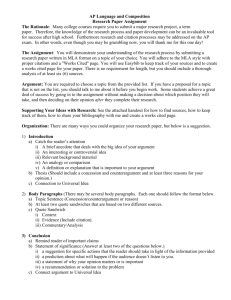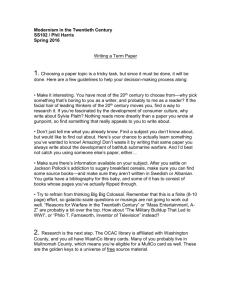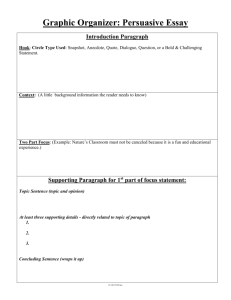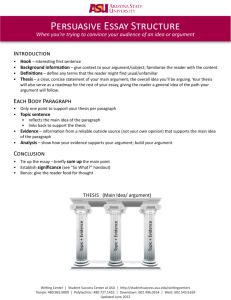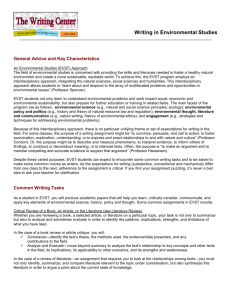WRITING A RESEARCH PAPER FOR A
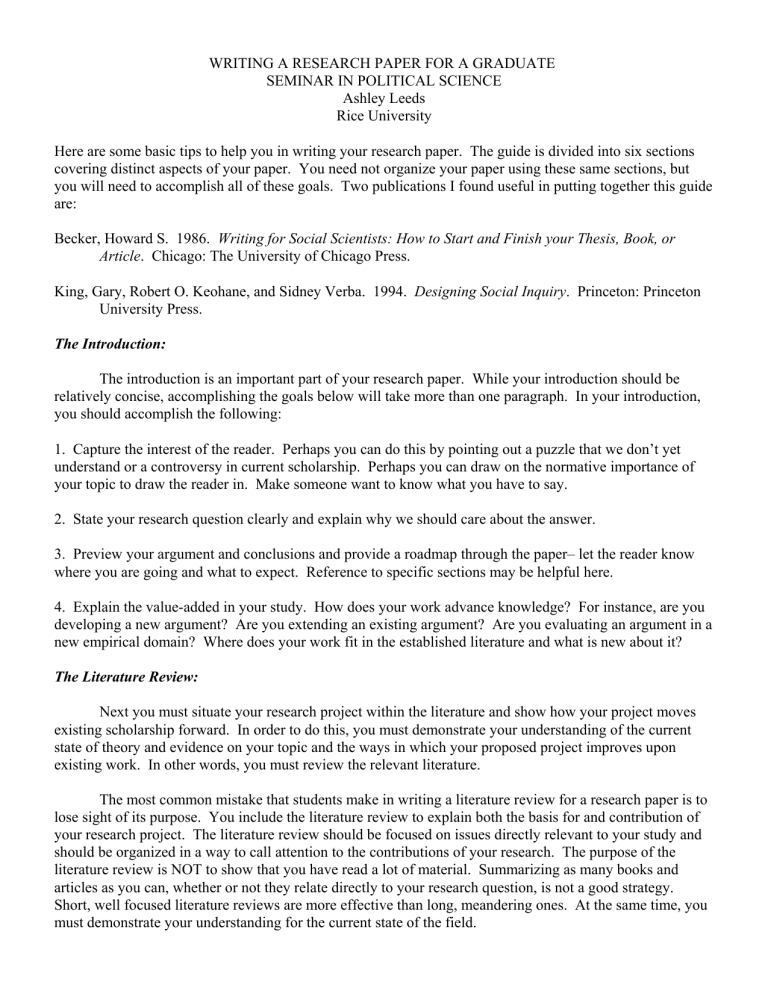
WRITING A RESEARCH PAPER FOR A GRADUATE
SEMINAR IN POLITICAL SCIENCE
Ashley Leeds
Rice University
Here are some basic tips to help you in writing your research paper. The guide is divided into six sections covering distinct aspects of your paper. You need not organize your paper using these same sections, but you will need to accomplish all of these goals. Two publications I found useful in putting together this guide are:
Becker, Howard S. 1986. Writing for Social Scientists: How to Start and Finish your Thesis, Book, or
Article . Chicago: The University of Chicago Press.
King, Gary, Robert O. Keohane, and Sidney Verba. 1994. Designing Social Inquiry . Princeton: Princeton
University Press.
The Introduction:
The introduction is an important part of your research paper. While your introduction should be relatively concise, accomplishing the goals below will take more than one paragraph. In your introduction, you should accomplish the following:
1. Capture the interest of the reader. Perhaps you can do this by pointing out a puzzle that we don’t yet understand or a controversy in current scholarship. Perhaps you can draw on the normative importance of your topic to draw the reader in. Make someone want to know what you have to say.
2. State your research question clearly and explain why we should care about the answer.
3. Preview your argument and conclusions and provide a roadmap through the paper– let the reader know where you are going and what to expect. Reference to specific sections may be helpful here.
4. Explain the value-added in your study. How does your work advance knowledge? For instance, are you developing a new argument? Are you extending an existing argument? Are you evaluating an argument in a new empirical domain? Where does your work fit in the established literature and what is new about it?
The Literature Review:
Next you must situate your research project within the literature and show how your project moves existing scholarship forward. In order to do this, you must demonstrate your understanding of the current state of theory and evidence on your topic and the ways in which your proposed project improves upon existing work. In other words, you must review the relevant literature.
The most common mistake that students make in writing a literature review for a research paper is to lose sight of its purpose. You include the literature review to explain both the basis for and contribution of your research project. The literature review should be focused on issues directly relevant to your study and should be organized in a way to call attention to the contributions of your research. The purpose of the literature review is NOT to show that you have read a lot of material. Summarizing as many books and articles as you can, whether or not they relate directly to your research question, is not a good strategy.
Short, well focused literature reviews are more effective than long, meandering ones. At the same time, you must demonstrate your understanding for the current state of the field.
A sure way to try a reader’s patience and to get off track in developing your argument is to produce a literature review that offers a list of summaries of individual books and articles without making clear how they fit together and why they represent a coherent body of work that serves as a starting point for your project. Literature reviews that start with “A number of scholars have studied the relationship between X and Y” and proceed to list who has studied the topic and what each scholar concluded may show your professor that you have read a lot of articles, but this type of literature review is unlikely to be an asset to your paper. A literature review should not be merely a technical reporting of what has been done before, but a creative organization of past work that helps to frame and build your argument. Good literature reviews order individual articles and books into groups, producing typologies that help readers to see unresolved debates, inconsistencies, and new questions clearly and quickly. By organizing past research in this way, you can convince the reader that your research, which will help to resolve these debates and/or inconsistencies or answer these new questions, is particularly important.
Howard S. Becker, in his book, Writing for Social Scientists (U of Chicago Press, 1986) describes a literature review as follows:
Imagine you are doing a woodworking project, perhaps making a table. You have designed it and cut out some of the parts. Fortunately, you needn’t make all of the parts yourself. Some are standard sizes and shapes . . .. Some have already been designed and made by other people . . .. All you have to do is fit them into the places you left for them, knowing that they were available. That is the best way to use the literature. You want to make an argument, instead of a table. You have created some of the argument yourself . . .. But you needn’t invent the whole thing. Other people have worked on your problem or problems related to it and have made some of the pieces you need. You just have to fit them in where they belong (141-142).
There are many possible ways of designing a literature review that can be effective. There is not one correct way to organize and report on the current state of the field. At the same time, it is very important to choose an organization scheme and to move purposefully from one point to another, guiding the reader to a conclusion. Your literature review should be designed to lead the reader to the conclusion that your research is an important next step in our understanding of the phenomenon in question.
One way of designing a literature review is as a debate among two or more competing theories of the same phenomenon. If your research can discriminate between the theories and allow for the conclusion that one may be more appropriate than the other, or if your research can integrate the theories and suggest that they are not competitors at all, this can be an effective way of framing your study. Another way is to set up your paper as a challenge to existing theory. Here, you use an existing body of literature as a “foil” and explain why your approach to the problem is superior. A third way is to demonstrate how existing literature has led to progressive refinement of our understanding of a phenomenon; this is particularly effective if your research serves as the “next step” in this refinement process. All of these approaches share the goal of demonstrating how your work will lead, however incrementally, to the continued cumulation of knowledge.
A good literature review will convince the reader that your project fits into an established body of work and addresses a question of concern to the scholarly community, and also that your project adds to our understanding of the topic by offering something new.
The Theory (Argument) and Hypotheses:
Drawing on your literature review, you must explain your argument to your reader clearly and fully.
This requires that you (1) identify the assumptions you are making and (2) show how you derive expectations about causal mechanisms and causal effects in a logical manner from those assumptions.
Theories must (1) provide a discussion of cause; (2) advance the goal of inference-- that is, be generalizable to a class of events beyond those you study; (3) be falsifiable– (in other words, you must be able to identify evidence that, if uncovered in empirical evaluation, would convince you your theory was wrong). Better theories provide more leverage over problems-- that is, they explain more with less. Inference, falsifiability, and leverage are all enhanced as you find more and more observable implications of your argument. Thus, do your best to identify as many observable implications of your theory as possible, even if you will not be able to test them all in this paper. Try also to identify the bounds of the theory. Under what conditions should it apply, and under what conditions would we expect it not to apply?
Pay careful attention to defining important terms. If you are studying “success” or “effectiveness” of international cooperation in a particular area, we need to know what that means to you. If you are discussing the impact of “bargaining power” on outcomes in international relations, we need to know what you mean by the concept of bargaining power. If you are studying international mediation, you must explain what actions do and do not constitute mediation by your definition. Be as concrete and specific as you can be in defining your terms and identifying your causal mechanisms. Please note that conceptual definitions are different from operational definitions– you should define your concepts separately from the measurements you employ in your empirical research.
Your argument should lead you to one or more hypotheses that you intend to evaluate in this paper.
Remember– hypotheses must specify an expected relationship between an independent variable and a dependent variable. State the hypotheses you intend to evaluate clearly and explicitly. Be careful not to conflate multiple ideas, and be as specific as your argument allows you to be. Please number your hypotheses and set them out from the text so they are absolutely apparent to the reader.
The Research Design:
In this section, you will explain to the reader how you intend to evaluate your hypotheses empirically. You must explain:
1. To what population should the hypothesis apply? What sample will you study, and how and why did you select this sample? Make sure to explain any unavoidable bias due to truncated variation in the dependent variable.
2. What is your unit of analysis, and how have you have measured your dependent variable and independent variables? You must explain where you got your information from, and how you determined values of the variables– what were your coding rules? Keep in mind that this step is necessary even if you are evaluating only a few cases and using words rather than numbers in your evaluation. You must still explain what criteria you used to determine whether (for instance) a state had a lot of bargaining power or very little, or whether a cooperative agreement was highly institutionalized or not, and how you obtained information about the cases.
3. What, if any, control variables are necessary to include in your analysis? Why do you include these control variables? Where did you get information on these variables, and what were your coding rules?
4. What method of analysis do you use to draw inferences and why? (For example, event history analysis, structured-focused comparison, boolean algebra, logit, etc.) Make sure to explain any particular aspects of the data analysis that require specific attention.
The Empirical Results:
Here you must present your analysis and a discussion of the results, as well as any robustness checks that you have performed. In constructing your tables and/or figures, make sure that you provide clear labels and a title. Readers looking at the table or graph should be able to see with no difficulty the relationship you intend to demonstrate and the population of cases that you examined. It is important, however, that you not only present the data in tables, but also explain it in words. Readers should be able to understand your key results simply from reading the text.
Not only should you present the data, but you should also evaluate the analysis. Based on these data, what conclusions do you reach about your hypotheses? Are there weaknesses in the tests of the hypotheses?
Are there particular cases that stand out as not matching expected patterns? Why might that be? It is useful to think as skeptically as you can about your findings and think of any other possible interpretation. How sure are you (in other words, how much uncertainty do you have) about the conclusions you draw based on this research?
The Conclusion:
In the conclusion, you should accomplish these goals:
1. Summarize what the reader has learned. What did you argue and what did the evidence show?
2. Discuss directions for future research. What does this project lead you to believe must be studied in the future? Did your analysis raise new questions? Were there things that you would have liked to be able to evaluate but were unable to?
3. Explain why your work was important. How did it advance scholarship and normative goals?
The particulars:
Your research paper should be:
1. Typed.
2. Double spaced.
3. In a reasonable font size (i.e., 11 or 12 point) with reasonable (i.e., approximately 1") margins.
4. Stapled in order with pages numbered.
5. Preceded by a title page with a meaningful title (i.e., not POLI 541 paper).
6. Divided into sections with appropriate subheadings.
7. Compliant with rules regarding citation.
8. Written with excellent grammar, spelling, and style.
Citation:
I do not require a particular citation format. I do require that the format be consistent and among the generally accepted formats for scholarly papers. (Check current political science journals for examples.) I prefer parenthetical citations in the paper and a bibliography at the end, but I will accept footnotes or endnotes. Works in a bibliography should always be listed in alphabetical order. All sources cited in the text must appear in the bibliography. Do not include sources in the bibliography that are not cited in the text.
Any information that is not common knowledge requires citation. When you report the ideas of others, you must offer appropriate credit. Citations are required whenever you discuss ideas from another
author’s work, not only when you quote directly. Plagiarism is a crime and a violation of the Rice
University Honor Code. Please be sure to familiarize yourself with the Rice Honor Council’s publications,
“Academic Fraud and the Honor Council.” In general, if you have any questions as to whether a citation is required, I encourage you to cite the source.
Every direct quotation must be followed immediately by a citation including the source and the page number. Avoid direct quotations except when they significantly enhance your argument. For instance, it may make sense to offer a direct quotation from a state leader when discussing current policy, especially if there is a single statement that defines the current policy. It also might make sense to quote an accepted conceptual definition directly. In most cases, however, you can make points more strongly by using your own words and offering appropriate acknowledgment to your source.
When you paraphrase an argument from a research source, it is always necessary to offer appropriate credit. Other people’s ideas always require citation. Indisputable facts, like the date Pearl Harbor was attacked by the Japanese, do not require citation. Any facts that are not indisputable, however, like survey results or economic impact assessments, do require citation. In addition, factual information that varies over time and/or by source should be cited. For instance, the percentage of the U.S. budget spent on defense varies over time; the source from which you draw such information is relevant. You are always encouraged to err on the conservative side and cite more often rather than less often.
If you draw several sentences or a paragraph of ideas from a single source, it is acceptable to cite the source once at the end of the paragraph or group of sentences rather than at the end of every sentence. It is not acceptable, however, to proceed to a new paragraph without crediting the ideas in the first paragraph.
Thus, every paragraph which includes any material requiring citation should contain citation(s).
